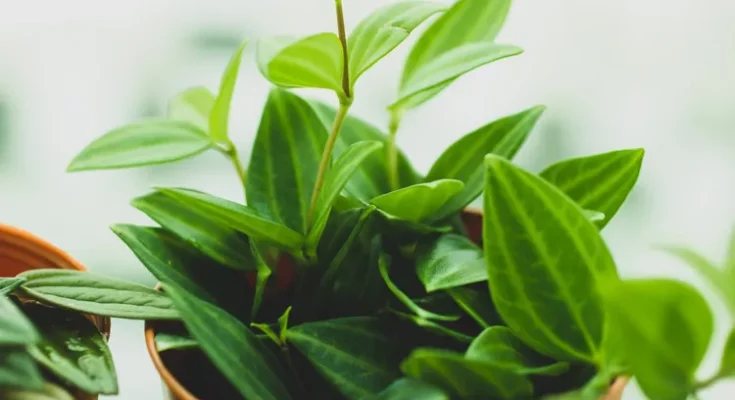What we call radiator plants are species belonging to the genus Peperomia. They’re not-so-distant relatives of the plants that produce the kitchen staple black pepper. These are heat-loving plants native to tropical and subtropical regions. Radiator plants vary in appearance, though many have small, flat leaves, and thick stems. They’re generally compact plants and slow-growing, making them good choices for indoor gardening, hanging baskets, and greenhouses.
The common name “radiator plant” likely came from American horticulturist Liberty Hyde Bailey, who—according to Charles Bixler Heiser in his 1985 book Of Plants and People—dubbed the species belonging to the Peperomia genus “radiator plants.” It’s an apt name, as the plants appreciate warm air and sunlight, though they can tolerate both wet and dry climates.
:max_bytes(150000):strip_icc():format(webp)/gettyimages-1066941116-2000-7bd679aac31e402c8730a8e8de1b87ae.jpg)
Peperomia species are grown for their attractive and vibrant ornamental foliage, which comes in an array of shapes and colors. Often, their leaves are rounded and shaped like hearts, though some have elongated, pointed leaves. Much of the foliage of Peperomia species is bright green, but it can also be striped, spotted, or marbled. Some also produce flowers and berries. Unlike many houseplants, peperomia are considered non-toxic to pets, another great reason to grow them.
The fuller leaves on some varieties of the radiator plant resemble that of a succulent—some refer to them as “semi-succulent.” These fleshy leaves mean the plant can retain water. There are more than 1,500 types of peperomia, and the main attraction is their foliage, with a wide choice in leaf shape, texture and color.
Peperomia Care
These plants are easy to grow indoors and don’t need very attentive care. They don’t take up much room as most won’t grow over a foot in height. Provide your radiator plants with bright or moderate, indirect light and occasional watering. Despite the name, radiator plants should not be set near a radiator or vents where temperatures can fluctuate and the air may be overly dry.
Light
Peperomia grow in the tropical understory or in the rotting wood of trees. Direct sunlight can scorch the leaves of peperomia, but low light will slow growth considerably. Depending on how much sunlight streams through your windows, an east-facing windowsill with a little filtered or dappled morning light can be a good location. Bright, indirect light also works well.
Soil
Use a slightly acidic, fast-draining potting mix for your peperomia. Look for a soil mix for succulents or a mix containing coco coir or orchid bark. Heavy soil retains too much moisture and can quickly lead to rot.
Water
Peperomia is fairly drought tolerant and many species prefer completely drying out before watering. A good rule of thumb is to water your plants once the top 2 inches of soil have dried (poke your finger in and it should feel dry to the touch).
Temperature And Humidity
Radiator plants are native to subtropical and tropical climates around the world. They grow best in temperatures of 65° to 80° F and should never be left outdoors when the temperature dips below 50°. If you move your plant outdoors in summer, keep it in a shady area and protect it from extreme cold or heat. Baby rubber plant (P. obtusifolia) can be grown as a ground cover in southern Florida.
Radiator plants like humidity even though they don’t need a lot of water. You can grow them in the bathroom or mist the leaves, but they also tend to do fine in dry indoor air.
Fertilizer
Peperomia grows just fine without any interference from fertilizer, though you can use an all-purpose houseplant liquid fertilizer in spring and summer while the plant is actively growing. Dilute the fertilizer to half strength and apply once every four weeks.
Types Of Radiator Plant
- Watermelon peperomia: P. argyreia (P. sandersii), also known as watermelon peperomia, has red stems and rounded leaves that are green and silver. Watermelon peperomia is more tolerant of low light and grows to 8-12 inches tall.
- Emerald ripple peperomia: P. caperata is known by the common name emerald ripple peperomia, grows to about 8 inches tall, and has pink stems and waxy green leaves. The leaves of the deeply veined selection ‘Rosso’ have red undersides.
- Baby rubber plant: P. obtusifolia (a.k.a baby rubber plant) has deep green foliage that’s oval-shaped and can be marbled with white, in the case of P. obtusifolia ‘Variegata.’ Non-variegated plants can tolerate lower light. Baby rubber plant can grow to 2 feet tall.
- Silverleaf peperomia: Ivy or silverleaf peperomia, P. griseoargentea, is another popular selection with stunning striped silver foliage that grows 6-12 inches tall.
- Raindrop peperomia: P. polybotrya has large, shiny, teardrop-shaped green leaves and grows about 12 inches tall. Raindrop peperomia needs bright light, but does not do well in direct sunlight.
- String of turtles: P. prostrata is a trailing peperomia with small, round, variegated leaves. String of turtles likes bright, indirect light and slightly moist soil, but it’s still a good idea to allow the top inch or two of soil to dry out before watering.
Pruning Peperomia
Remove any spent flower spikes as well as dead or diseased foliage and stems. If the plants become leggy, you can trim them back and use the cuttings to propagate new plants.
Propagating Peperomia
What You Need
- Small pruners
- Planting tray
- Light-weight, sterile potting mix
- Clear plastic dome or stakes and clear plastic wrap
- Spray bottle for misting
- Optional: Rooting powder
Peperomia are easy to propagate by leaf or stem cuttings as long as you monitor and care for the plants while the roots are developing. Take cuttings in spring or summer during the growing season for the best results. For small-leafed plants, cut a stem with at least three leaves, then remove the bottom leaves and leave two at the top. For large-leafed plants, you can also use a single leaf just at the node where it meets the stem. Then follow these steps:
- Stick the stems into a tray of damp, light-weight potting mix so that they stand upright. For large leaf cuttings, trim off the top half or third of the leaf with pruners before doing so. (Optional: Dip the bottom of each stem into rooting powder before planting).
- If you have a clear plastic dome, place it over the tray. Alternatively, place chopsticks or stakes around the edges of the tray, then cover the tray with clear plastic wrap, making certain it doesn’t touch your cuttings.
- Place the tray indoors where it gets indirect light. Check the soil regularly and mist or water lightly to keep slightly moist.
- Remove the dome or plastic wrap once new growth appears. Continue to water until the plants are well rooted and you can transplant them into small pots.
Potting And Repotting Radiator Plant
Most radiator plants are slow growing and only need to be repotted every two to four years. Use a light, fast-draining succulent potting mix and pot up your plant in a container one size bigger than its current pot. Avoid going up too many sizes, as water retention in a large pot can lead to root rot. The plant just needs an extra inch around the root ball to adjust to the new pot properly.
Common Pests & Plant Diseases
Peperomia are for the most part pest resistant. If mealybugs, or spider mites become a problem, treat with weekly sprays of neem oil or insecticidal soap. Use traps for fungus gnats.
Soft, mushy, browning stems and yellow leaves that drop off the plant are signs of stem and root rot. Examine the roots for rot, trim off damaged roots and stems, and repot in fresh potting soil. Reduce the watering schedule and provide a little more light if your plant has been living in low light.
Common Problems With Peperomia
When it comes to problems with these easy-care plants, over-watering is the most likely culprit. Here are a few other things to watch out for with radiator plants.
Fading Leaves
If the leaves become dull or fading, it is being exposed to too much direct sunlight. Move the plant to a more sheltered location. Fading leaves sometimes indicate a nutrient deficiency, so consider fertilizing the plant if it is spring or summer.
Wilting Leaves
Is your radiator plant wilting along with the potting mix feeling dry? In this case, the plant is under-watered. Should you see wilting accompanied by yellowing and leaf loss, this is a result of overwatering.
Brown Leaves
If the edges of leaves turn brown and crispy, your plant probably needs protection from the scorching sun. Very dry air, such as from a heating vent, can also cause this problem. Move the plant to a more suitable location.
Leggy Growth
If growth becomes too leggy, pinch back stems (you can use them to propagate new plants). A little more light may help keep the plant fuller.



